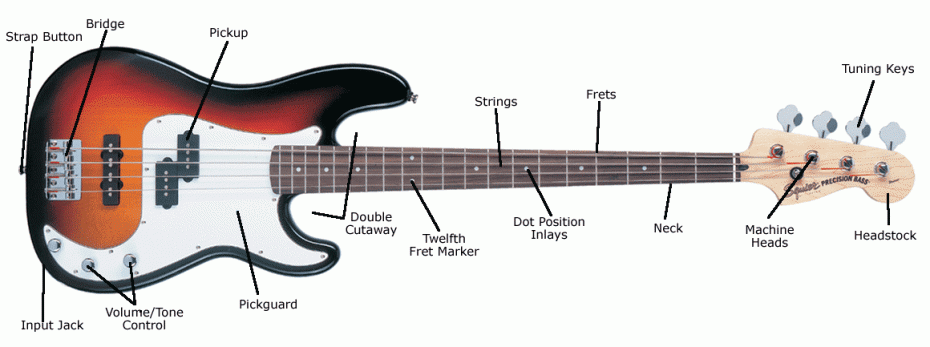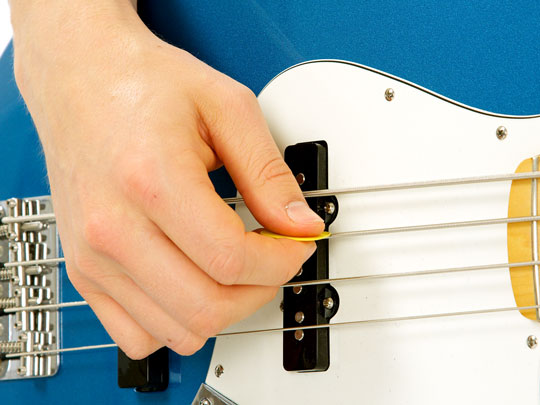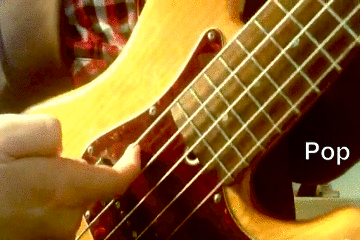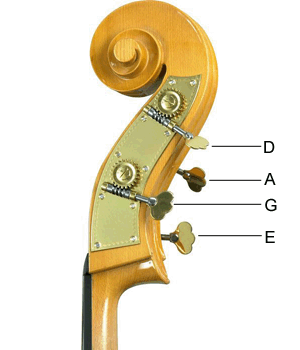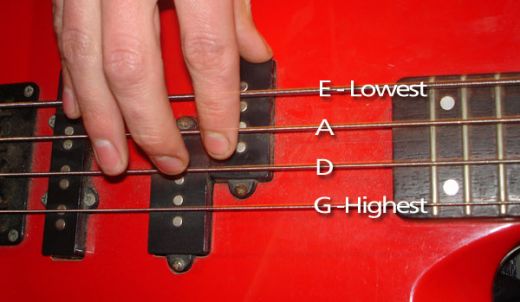Bass is a term that refers to several things. First of all, the bass is an instrument with a deep sound, referring to either a double bass or bass guitar. Secondly, the term “bass” refers to strong vibrations in a song (made by the instrument with the same name). Lastly, bass can refer to a type of fish – but we’re not interested in that at the moment.
Throughout history, the bass always had the same role in music arrangements, and it’s quite impressive that it has held on to the same job for nearly 6 centuries.
If we compare “modern basses” with “classical basses,” there would be various similarities between them, but also a lot of differences. First of all, classical basses were equipped with four strings (and that was a rule) while the bass guitars of today can have up to 10 strings or more (often used in alternative and progressive music).
Let’s take a look at the different types of basses – here we’ll explain the manifold of differences and similarities between the many types of basses.
What are different types of basses?
Origins of the first basses
The original bass was invented in the 15th century, and, ever since then, it has received various modifications, both in design and performance. The first bass was often referred to as the bass violin, mainly because the play style resembled that of a violin, but the sound was much deeper.
Bass Violin and Bass Viola
These violin basses were actually conversions of standard violins. Soon after, creative musicians devised a way to create bass violas with the same principles of viola but with a deeper sound. After several decades, the first upright bass came to be.
Even though these bass types are the archetypes of bass guitars, they’re quite obscure nowadays. The only logical reason why you will have a hard time finding a bass violin or a bass viola is because there are modified, superior violins and violas that are more than competent of replacing their predecessors.
The original bass violas and violins don’t actually sound like your average bass. Violins sound very high-pitched, and violas sound only slightly deeper. Even with various modifications, a bass violin (or bass viola) can’t produce the deep sound that you’ll get from an average bass (or contrabass).
Double Bass
The last of the classical bass family is the double bass. This instrument is the largest of the bunch, and it features the deepest sound. Some musicians refer to the double bass as contrabass, especially in Europe, mainly because it features the sound range in contra octaves. This type of bass is also known as an upright bass.
A classical upright bass featured a pick at the bottom which allowed the musician to easily maneuver and rotate the bass more easily. The sound of this type of bass was even deeper when compared to bass violins and bass violas.
The upright basses were used for quite a while, and they are still a part of classical orchestras today. An upright bass sounds pretty deep, but it still retains the clarity needed to complement the melodic harmonies in orchestras. Standalone upright bassists are a rarity these days, mainly because these instruments are more expensive and harder to transport when compared to bass guitars.
The double bass is a very special instrument that is mainly used in large orchestras. The design of a standard double bass is such that it’s larger than any other stringed bass instrument, and the sound is deeper from any other bass stringed instrument. The double bass is either played with a bow or a pluck, as it’s hardly imaginable that the player can strum the strings with fingers.
Brass Bass – The only “bass” that doesn’t belong in the classical bass family
The term “bass” also refers to the “brass bass” – a brass instrument that is often used in brass orchestra bands (alongside tubas, saxophones, and such). This is the only “bass” that’s not actually the bass, even though it does sound quite deep and vibrates in a similar way.
Double Bass Playing Styles
Using the Bow
The typical way that basses are played is with the use of the bow. The bow is drawn across the string with the right hand to produce and sound and the bassist uses their left hand to finger the correct pitches on the strings. Rosin on the bow creates friction on the bass string which causes the string to vibrate.
Plucking the String
Another way that bassists can play is by plucking the string using pizzicato. This creates a unique sound that sounds similar to a harp being plucked. Typically this style is used in bluegrass or country music.
Electric Bass – The Modern Bass Guitar
There is a reason why electric bass guitars deserve special attention. For starters, one can hardly say that there’s a standard that defines a modern bass guitar. The market for electric basses is vast, there’s a manifold of manufacturers that offer a wide variety of models, and the playing style of modern bassists can’t really compare to that of the old-fashioned play style.
Design of the Electric Bass guitar
The standard electric bass guitar features a shape that looks like an electric guitar. However, there are various models that look smaller, larger, and there are unique models that can’t be exactly described as an instrument. For instance, there are some guitars that have the shape of a sword, a rifle, or even a toilet seat.
Most electric bass guitars have four strings, so they only have four tuners as compared with a standard guitar’s six strings.
The Sound of Electric Bass Guitar
The electric bass guitar’s sound mainly depends on the playing style of the bassist, the set-up, and the strings the bassist uses. There are certain strings that sound quite metal and industrial, but there are also certain types of precision strings that let out more sustained notes.
As for the matter of set-up, each musician (and electronic technician) does the work in a unique way. Plainly speaking, there are no two instruments that sound the same. Also, electric bass guitars are often wired to an amplification device, which heavily impacts the sound purity, density, and volume in general.
Bass guitarists can also use synthesizer pedals to modify the sound the bass guitar makes. In this case, bass guitars can pretty much sound any way the bassist wants it to sound.
Electric Bass Guitar Playing Styles
How a bassist plays his instrument is a matter of preference, but also a matter of the music genre. There are some genres that are supposed to be played in one way, and one way only (for example, heavy metal music and fast-paced music often requires the use of pick).
All in all, there are three main picking styles of electric bass guitars – Slap & Pop, Pick strumming, and finger style. Each method has a set of advantages, and it greatly impacts the sound and performance.
What playing style will be used mainly depends on the song itself, but it’s often determined by the music genre and the skill set of the bassist. Professional bassists often employ the use of complex playing techniques while amateur and casual bassists often simply use a guitar pick to pluck the strings.
Finger Style
Modern bassists are often complimented when they play their instrument with fingers. The main benefits of this play style involve the precise tone, noise manipulation, stop-action techniques, and more. This, however, creates a lot of physical pressure on the fingertips of the bassist, so this is considered to be an advanced play style. As such, calluses may form on the fingertips and hands. These calluses can be a sign that you are a great bassist!
Pick play style
Bassists who don’t want to play their instrument with fingers often use a guitar pick. There are also certain fast-paced music genres that require the bassist to use a pick. The main benefits of pick playing style are faster reaction during playing, better accentuation, but this playing style limits the bassist from using certain techniques (such as finger tapping, for example, even though professionals still manage to use them).
Slap & Pop play style
Most people think that slap and pop isn’t a style. Instead, people advocate the statement that these two are actually techniques in the bassist’s arsenal. Since there are some music genres where bassists slap and pop their instrument constantly, it’s safe to say that this is not a technique – rather it’s a play style in its own right.
Tuning your bass
Tuning a bass guitar isn’t rocket science, but it’s still harder than tuning an electric guitar. The standard bass tuning is Standard E, where the strings should be tuned as following (starting from the largest string) – E, A, D, G.
Since most basses come with a set of four strings, the standard E tuning is quite simple to achieve. Simply attach the strings to your bass guitar. The largest and widest string E should be on the very top, and the thinnest G should be the last.
The bass strings are very, very hard, so you may spend some time finding the correct position of your tuners. Anyhow, this work is mostly performed by professionals, and you shouldn’t try too hard if you’re inexperienced. With the invention of electric tuners, the job is made a little easier, but it’s still quite hard to properly tune your bass.
If you’re having trouble, you can always take your bass to a local music shop, where professionals will gladly do it for you. Some people charge this service, but it’s always cheap.
Conclusion
There are many types of basses – acoustic basses, acoustic electric basses, double basses, and bass guitars, and lots of different playing styles. Playing a double bass or bass guitar requires a lot of time and patience, and the best way to do so is by actually playing it.
Every start is hard, and starting out with a double bass or bass guitar can be frustrating, but it’s also rewarding. You may question your skill from time to time, but you should never give up – the learning curve of a bass guitar is quite sharp, so just be persistent and you’ll do just fine.



